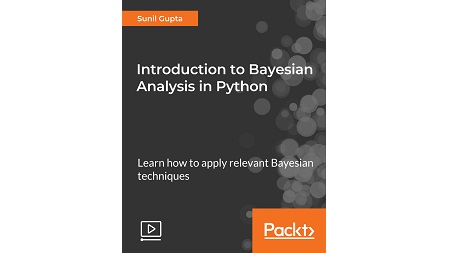
English | MP4 | AVC 1920×1080 | AAC 48KHz 2ch | 1h 10m | 234 MB
This course focuses on the application of relevant Bayesian techniques
Bayesian statistics is an effective tool for solving some inference problems when the available sample is too small for more complex statistical analysis to be applied. This course teaches the main concepts of Bayesian data analysis. It focuses on how to effectively use PyMC3, a Python library for probabilistic programming, to perform Bayesian parameter estimation, model checking, and validation.
The course introduces the framework of Bayesian Analysis. Complex mathematical theory will be sidestepped in favor of a more pragmatic approach, featuring computational methods implemented in the Python library PyMC3. We present several instances of analysis scenarios.
The user is expected to know basic Python programming. Knowledge of scientific Python packages such as NumPy, SciPy, Matplotlib, Seaborn, and Pandas is a plus but not mandatory. However, a basic understanding of probability is necessary to grasp the fundamentals of the Bayesian framework. Familiarity with the notion of random variables and distributions will enable you to follow along with the course.
What You Will Learn
- Understand the essentials Bayesian concepts from a practical point of view
- Learn how to build probabilistic models using the Python library PyMC3
- Acquire the skills to sanity-check your models and modify them if necessary
- Implement parametric models for your generalized linear models
- Add structure to your models and get the advantages of hierarchical models
- Find out how different models can be used to answer different data analysis questions
- Learn how to think probabilistically and unleash the power and flexibility of the Bayesian framework
Table of Contents
INTRODUCTION AND THEORY
The Course Overview
Statistical Modeling
Bayes’ Theorem
The Coin-Flipping Problem (Theory)
The Coin-Flipping Problem (PyMC3)
PARAMETRIC MODELS
Multiparametric Models
Linear Regression
Hierarchical Linear Regression
Logistic Regression -Introduction
Logistic Regression – Example
THE BAYESIAN ANALYST’S TOOLBOX
Choosing Priors
Loss Functions
Model Evaluation
FINAL PROJECT – OBSERVING THE DARK WORLD
Choosing Priors
Constructing a Loss Function
PyMC3 Implementation
Training and Results
Resolve the captcha to access the links!